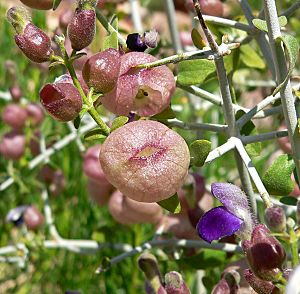Scutellaria mexicana facts for kids
Quick facts for kids Scutellaria mexicana |
|
|---|---|
 |
|
| Flower and "bladders" | |
| Scientific classification | |
| Genus: |
Scutellaria
|
| Species: |
mexicana
|
| Synonyms | |
|
|
Scutellaria mexicana, also known as bladder sage or paperbag bush, is a type of shrub. A shrub is a woody plant smaller than a tree. It belongs to the mint family. This plant is special because of its unique flower parts, called calyx lobes. These lobes grow into small, bag-like shells around the plant's fruits.
Contents
Where Bladder Sage Lives
This interesting plant grows across the southwestern deserts of North America. You can find it in places like sandy slopes, dry riverbeds (called washes), and canyons. It's common in plant areas like creosote bush scrub and Joshua tree woodland. These areas are found in the Mojave, Sonoran, and Chihuahuan Deserts.
You can spot it in southern California, Nevada, southwestern Utah, Arizona, and western Texas. It also grows south into Mexico, in states like Chihuahua, Sonora, and Baja California. These bushes often grow mixed with other shrubs. Even though their leaves and flowers are not very dense, their unique bags make them easy to see from far away.
What Bladder Sage Looks Like
How it Grows
The bladder sage plant usually forms a round shape. It typically grows to be about 50 to 100 centimeters (about 20 to 40 inches) tall. Sometimes, it can grow even larger.
Stems and Leaves
The stems of this plant spread out in a stiff way. Their tips often become sharp, like spines. The branches grow in a special pattern, with side branches forming right angles to the main stem. This plant can drop its leaves when conditions are dry. This is called being drought deciduous.
The leaves grow in pairs on opposite sides of the stem. They are small, usually 3 to 15 millimeters long and 2 to 8 millimeters wide. They are oval-shaped and have smooth edges. They have a very short or no leaf stalk, which is called a petiole.
Flowers and Fruit
The flowers of the bladder sage have two lips. They grow in pairs, facing away from each other. The top lip is white to light purple and feels hairy. The bottom lip has three parts and is a deep, dark purple color.
When the flower is young, its calyx (the green part that holds the flower) is reddish-purple. As the flower gets older, this calyx grows into its famous bag shape. These bags can be 1 to 2 centimeters (about 0.4 to 0.8 inches) wide. The dried flower eventually falls out of a hole in the end of the bag.
Inside these dried calyx bags, the fruit is made of four small nutlets. The dried bags are very helpful for spreading the seeds. When the wind blows, it can carry the bags, helping the seeds travel to new places.
Bladder sage usually flowers from April through June. However, the papery bags are very strong. They can stay on the plant even into winter, long after the flowers are gone.
Plant Name History
The plant's old name, "Salazaria", was given to honor José Salazar y Larregui. He was an astronomer from Mexico. He helped with the survey of the border between the United States and Mexico from 1848 to 1855.

